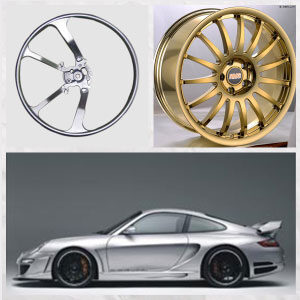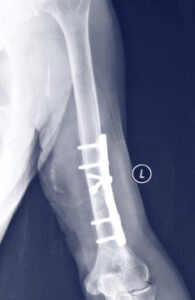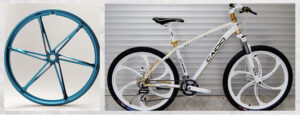Application of raw magnesium
The application of primary magnesium is mainly concentrated in the production of magnesium alloys, steelmaking desulfurization, and also used in rare earth alloys, metal reduction, corrosion protection and other fields. Many steel mills use magnesium for desulfurization. The desulfurization effect of using magnesium particles is better than calcium carbide. The use of magnesium sacrificial anodes for cathodic protection is an effective method to prevent metal corrosion. Magnesium sacrificial anodes are widely used in petroleum pipelines, natural gas, Corrosion protection of gas pipelines and storage tanks, smelters, gas stations, and water heaters, heat exchangers, evaporators, boilers and other equipment.
Application of magnesium alloy
Magnesium alloy has good lightweight, machinability, corrosion resistance, shock absorption, dimensional stability and impact resistance, far superior to other materials. These characteristics make magnesium alloys have applications in a wide range of fields, such as transportation, electronics industry, medical field, military industry, etc. This trend is only increasing. Especially in the fields of 3C products (computers, consumer electronics, communications), high-speed rail, automobiles, bicycles, aerospace, architectural decoration, hand tools, medical rehabilitation equipment, etc., it has good prospects and great potential, and has become a new material in the future. One of the development directions. The Ministry of Industry and Information Technology in the “Twelfth Five-Year Plan” period supports the development of more than 400 new material catalogs.
Transportation
(1) Airplane
Since the 20th century, magnesium alloys have been used in the aerospace field. Because magnesium alloy can greatly improve the aerodynamic performance of the aircraft and can significantly reduce its structural weight, many parts are made with it. The general aviation magnesium alloys are mainly plates and extruded profiles, and a small part are castings. At present, the application fields of magnesium alloys in aviation include various civil and military civil aircraft parts, propellers, gear boxes, bracket structures and some parts of rockets, missiles and satellites. With the development of magnesium alloy production technology, performance will continue to improve and the scope of application will continue to expand.
(2) Car
Magnesium alloys have been widely used by developed countries in automobile dashboards, seat brackets, gearbox housings, steering system components, engine covers, doors, engine blocks, frames and other components. The use of magnesium alloys to manufacture auto parts can significantly reduce the weight of the car, reduce fuel consumption, reduce exhaust emissions, improve the integration of parts, and increase the flexibility of car design. Generally, for every 10% reduction in vehicle weight, fuel efficiency can be increased by 5.5%, and exhaust emissions are reduced accordingly. To make cars lighter, there are two ways: one is to optimize the structural design; the other is to choose lightweight materials. Aluminum alloys, plastics (resin-based composite materials), and magnesium alloys are currently considered three ideal types of materials. Magnesium alloy die-casting is the lightest of all die-casting alloys and is a very competitive lightweight material for automobiles. A large number of magnesium alloy parts are produced to replace plastic, aluminum alloys, and even steel parts. With the development of technology, the application range of magnesium alloys in the automotive field will be wider.
Telecommunication
Due to the development of digital technology in the electronic information industry, the market has become more and more highly integrated, light and thin, miniaturized, and in line with environmental protection requirements for electronic and communication products. Engineering pigments used to be the main material, but their strength cannot be compared with metals after all. Magnesium alloy has excellent thin-wall casting performance, the wall thickness of its die-casting parts can reach 0.6~1.0mm, and maintain a certain strength, stiffness and crash resistance, which is very conducive to the requirements of ultra-thin, ultra-light and miniaturized products , Which is unmatched by engineering pigments.
At present, electrical products made of magnesium alloy components include cameras, camcorders, digital cameras, notebook computers, mobile phones, televisions, plasma displays, and hard disk drives. Driven by the development of 3C products represented by notebook computers, mobile phones and digital cameras in the direction of light, thin, short and small, the application of magnesium alloys has continued to grow.
1. Notebook computer
The use of magnesium alloy as the chassis of the notebook computer is based on almost all the advantages of magnesium alloy. The shockproof performance improves the reliable operation of computer components; the anti-electromagnetic interference and electromagnetic shielding performance ensure the computer’s information security; excellent thermal conductivity, greatly improved Computer cooling problem.
2. Cell phone
The mobile phone utilizes the special functions of magnesium alloy to prevent shock, wear and shield electromagnetic waves, and can meet the requirements of light, thin, short and small. At the same time, the mobile phone adopting the magnesium alloy casing has greatly improved the electromagnetic compatibility, which reduces the electromagnetic wave loss during the communication process and also reduces the damage of the electromagnetic wave to the human body. According to statistics, 400 million mobile phones were produced globally in 2005, and about 10% to 11% of them used magnesium alloy casings.
3. Digital Camera
The skeleton of the SLR camera is usually made of magnesium alloy. Generally, high-end and professional digital SLR cameras use magnesium alloy as the skeleton, which makes them durable and good in feel.
Medical treatment
In the medical field, magnesium was first introduced as an orthopedic biomaterial. Because of its many features and attributes, magnesium implants and similar applications have become very attractive options. In the early days, stainless steel, titanium alloys and cobalt-chromium alloys were used for medical implant metal materials. Their advantage is their good corrosion resistance, which can maintain the overall structural stability in the body for a long time. However, after a period of time after implanting these metal materials, many patients will suffer. Because these materials cannot be fused with the body, harmful metal ions are eluted, causing human allergies, and they need to be taken out through a second operation after healing.
Therefore, biodegradable medical metal materials have become the future research and development direction of implant materials, and magnesium alloys that are closest to human bone density have unique advantages (magnesium alloy density is about 1.7g/cm³, human bone density is about Is 1.75 g/cm³).
Magnesium alloy is easy to process and has excellent comprehensive mechanical properties and unique biodegradation function. Magnesium is one of the macro metal elements necessary for human body, so magnesium alloy is the best choice for medical metal materials. The elastic modulus of magnesium alloy is about 45GPa, which is also close to human bone (10~40GPa), which can effectively relieve or even avoid the “stress shielding effect”; the magnesium ions released by the magnesium alloy in the human body can also promote the proliferation of bone cells and Differentiation, promote bone growth and healing. Not only that, the processing performance of magnesium alloys is far superior to other types of degradable implant materials such as polylactic acid and calcium phosphate, so it also has clinical application value in cardiovascular stents.
Military industry
The use of magnesium alloys in military equipment can increase the strength of structural parts, reduce the weight of equipment, and increase the hit rate of weapons. At the same time, magnesium alloys can meet the requirements of materials such as aerospace and other high-tech fields for noise absorption, shock absorption and radiation protection, and significantly improve the aerodynamic performance of the aircraft and reduce the structural weight. Therefore, magnesium alloys are often used in the manufacture of cabinets, wall panels, brackets, wheels, and engine blocks, cylinder head boxes and pistons of aircraft and land vehicles. At the same time, magnesium alloys are also used to manufacture some military equipment , Such as bunker brackets, mortar bases and missiles. With the in-depth study of magnesium alloys and the improvement of material properties, magnesium alloys will be used more and more in weapons.
Other application
Magnesium alloys are also widely used in other small areas in our lives, such as motorcycles and bicycles. Bicycles are new applications of magnesium alloys and are mainly used as bicycle frames. The advantage of magnesium alloy is that it is not only light, fast and comfortable, but also has a mouth to make the pipe diameter smaller, the pipe wall thinner, and the frame stronger. The weight of the folding bicycle frame made of magnesium alloy is only 1.4kg; one of the representative equipment of rehabilitation facilities is a wheelchair. The commercially available wheelchairs can be divided into three types: standard and lightweight (aluminum alloy or titanium alloy) The materials used are steel pipe, aluminum pipe and titanium pipe. The AZ31 magnesium alloy is used to make the wheelchair frame or the other parts except the wheels are basically made of magnesium alloy. The wheelchair can reduce weight by about 15%, which is both lightweight and flexible. Magnesium alloys are mainly used in marine equipment, underwater weapons, seawater batteries, diving suits, sacrificial anodes, timing devices, etc. in the shipbuilding industry and marine engineering. There are countless application fields, which play an important role in our lives.

 Deutsch
Deutsch Français
Français 日本語
日本語 Español
Español




